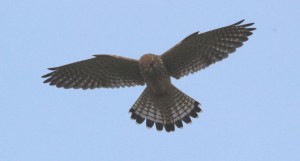 Birds of prey in Scotland are frequently in the headlines in the various media for a number of reasons. The red kites and the sea eagles are good examples because of the re-introduction programmes of both these birds that have been successful despite the illegal killing of them, particularly the red kites. Golden eagles make the headlines because of all the birds they are perhaps the most iconic, particularly in the Highlands. Buzzards make the headlines because of persecution in various forms but there is one bird that rarely gets mentioned, the kestrel. The kestrel is one of the smallest of the birds of prey, only the merlin is smaller, and at one time it used to be the commonest in Scotland, even commoner than the buzzard. Some readers may recall when kestrels could be seen hunting over fields and roadside verges and they were so common perhaps people just accepted them.
Birds of prey in Scotland are frequently in the headlines in the various media for a number of reasons. The red kites and the sea eagles are good examples because of the re-introduction programmes of both these birds that have been successful despite the illegal killing of them, particularly the red kites. Golden eagles make the headlines because of all the birds they are perhaps the most iconic, particularly in the Highlands. Buzzards make the headlines because of persecution in various forms but there is one bird that rarely gets mentioned, the kestrel. The kestrel is one of the smallest of the birds of prey, only the merlin is smaller, and at one time it used to be the commonest in Scotland, even commoner than the buzzard. Some readers may recall when kestrels could be seen hunting over fields and roadside verges and they were so common perhaps people just accepted them.
For most of the 20th century the kestrel was the commonest bird of prey in Scotland but then came the downfall with the numbers falling by 67%. In contrast the buzzards recovery from very low numbers after the effect of chemicals and the stabilisation of the sparrowhawk numbers meant the kestrel fell to third place in terms of breeding numbers in Scotland. There have been all sorts of theories about the drastic decline of the kestrel but most people blame the widespread and dramatic changes in agricultural techniques. This has led to the marked decline of the main prey of the kestrel, the voles, and in particular the short-tailed vole. Although they will take other prey from worms to small birds and baby rabbits to beetles, the various voles are still their mainstay. As for the future of the kestrel it may well be in our hands in the form of changing farming techniques for some people, the provision of nestboxes which they readily take to and the management of nature reserves in their various forms. At present there are estimated to be around 7,500 pairs in Scotland so let us hope we can build on that so that this delightful “windhover”, to give it its local name, is no longer so unusual.
Although a few people are enthusiastic about training kestrels for falconry they are generally at the bottom of the list of birds of prey used in this pastime. There was an upsurge of interest after the famous film “Kes” that came out in 1969. It tells the story of a working class boy, Billy Casper, who had little hope of any life but that of a coal miner until he finds an outlet through training a kestrel that he takes from a nest on a farm. However, some poets have waxed lyrical about the bird and perhaps the most well known one is by Gerard Manley (1844-1899) who exalted in their mastery of flight and their majesty in the sky.
“I caught this morning’s minion, king- / dom of daylight’s dauphin, daplle-dawn–drawn Falcon, in his riding.”
As for the photograph, I took this along the east coast at Rockfield where this kestrel was repeatedly hovering in the up current of air from a low cliff near the shore line. Despite the fact that I was only about twenty yards from the bird it completely ignored me and when I left it was still hovering there. This is the typical hovering pose of the kestrel with tail outstretched and the small feathers on the joint of the wing can clearly be seen sticking out. These are called alula feathers and the bird can project these out to allow it to hover without stalling.
Tags: highland birds
